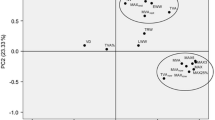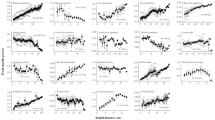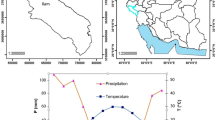Abstract
We measured radial variation of carbon isotope composition and vessel traits in tree species in seasonally dry forests of Northeast Thailand to explore a more reliable and amenable method of tropical dendrochronology for trees that lack visually detectable and consistent growth rings. Six Dipterocarpaceae species (3 Shorea, 2 Dipterocarpus, and 1 Hopea species) with indistinct or irregular growth rings and teak (Tectona grandis), a species which forms distinct growth rings, were examined. The δ13C value variations in all species showed annual cyclicity. Dipterocarpaceae species usually marked the lowest values of δ13C in the middle of the growing season, whereas teak had the lowest values at nearly the end of the growing season. Since the growing season of the species examined almost corresponds to the rainy season in the study area, the δ13C variation was likely caused by the change in moisture availability. The different variation pattern of teak was attributable to its stronger dependence on 13C-enriched reserved material early in the growing season. Changes in tree vessel traits for all species examined also showed annual cyclicity. Dipterocarpaceae species showed significant correlation between δ13C values and vessel measurements. Vessel lumen (mean area, tangential and radial diameter, and proportion of total area) had a negative correlation, whereas vessel frequency showed a positive correlation. The correlations indicated that changes in vessel traits were caused by the seasonal variation of moisture available to the trees. Thus, we concluded that methods using wood anatomy, as well as δ13C, have great potential for use as tools in tropical dendrochronology within the context of seasonal climate.







Similar content being viewed by others
References
Arnold DH, Mauseth JD (1999) Effects of environmental factors on development of wood. Am J Bot 86:367–371. doi:10.2307/2656758
Baker TR, Affum-Baffoe K, Burslem DFRP, Swaine MD (2002) Phenological differences in tree water use and the timing of tropical forest inventories: conclusions from patterns of dry season diameter change. For Ecol Manage 171:261–274
da Silva RP, dos Santos J, Tribuzy ES, Chambers JQ, Nakamura S, Higuchi N (2002) Diameter increment and growth patterns for individual tree growing in Central Amazon, Brazil. For Ecol Manage 166:295–301
Evans MN, Schrag DP (2004) A stable isotope-based approach to tropical dendroclimatology. Geochim Cosmochim Acta 68:3295–3305. doi:10.1016/j.gca.2004.01.006
Farquhar GD, O’Leary MH, Berry JA (1982) On the relationship between carbon isotope discrimination and the intercellular carbon dioxide concentration in leaves. Aust J Plant Physiol 9:121–137
Ferrio JP, Voltas J (2005) Carbon and oxygen isotope ratios in wood constituents of Pinus halepensis as indicators of precipitation, temperature and vapour pressure deficit. Tellus 57B:164–173. doi:10.1111/j.1600-0889.2005.00137.x
Fichtler E, Clark DA, Worbes M (2003) Age and long-term growth of trees in an old-growth tropical rain forest, based on analyses of tree rings and 14C. Biotropica 35:306–317
Green JW (1963) Methods of carbohydrate chemistry. Academic Press, New York
Harlow BA, Marshall JD, Robinson AP (2006) A multi-species comparison of δ13C from whole wood, extractive-free wood and holocellulose. Tree Physiol 26:767–774
Helle G, Schleser GH (2004) Beyond CO2-fixation by Rubisco–an interpretation of 13C/12C variations in tree rings from novel intra-seasonal studies on broad-leaf trees. Plant Cell Environ 27:367–380. doi:10.1111/j.0016-8025.2003.01159.x
Kamo K, Kiatvuttinon B, Puriyakorn B (1995) Growth dynamics of some broad-leaved tree species in central Thailand. In: Box EO (ed) Vegetation science in forestry. Kluwer Academic, Dordrecht, pp 515–528
Leavitt SW (2002) Prospects for reconstruction of seasonal environment from tree-ring δ13C: baseline findings from the Great Lakes area, USA. Chem Geol 192:47–58. doi:10.1016/S0009-2541(02)00161-4
Leavitt SW, Danzer SR (1993) Method for batch processing small wood samples to holocellulose for stable-carbon isotope analysis. Anal Chem 65:87–89. doi:10.1021/ac00049a017
Mariaux A (1967) Les cernes dans les bois tropicauax africains, nature et periodicite. Bois For Trop 113:3–14 114:23–37
McCarroll D, Loader NJ (2004) Stable isotopes in tree rings. Quat Sci Rev 23:771–801. doi:10.1016/j.quascirev.2003.06.017
Nobuchi T, Ogata Y, Siripatanadilok S (1995) Seasonal characteristics of wood formation in Hopea odorata and Shorea henryana. IAWA J 16:361–369
Ohashi Y, Sahri MH, Yoshizawa N, Itoh T (2001) Annual rhythm of xylem growth in rubberwood (Hevea brasiliensis) trees grown in Malaysia. Holzforschung 55:151–154. doi:10.1515/HF.2001.024
Oliver CD, Larson BC (1996) Forest stand dynamics. Wiley, New York
Ponton S, Dupouey JL, Breda N, Feuillat F, Bodenes C, Dreyer E (2001) Carbon isotope discrimination and wood anatomy variations in mixed stands of Quercus robur and Quercus petraea. Plant Cell Environ 24:861–868. doi:10.1046/j.0016-8025.2001.00733.x
Poussart PF, Schrag DP (2005) Seasonally resolved stable isotope chronologies from northern Thailand deciduous trees. Earth Planet Sci Lett 235:752–765. doi:10.1016/j.epsl.2005.05.012
Poussart PF, Evans MN, Schrag DP (2004) Resolving seasonality in tropical trees: multi-decade, high-resolution oxygen and carbon isotope records from Indonesia and Thailand. Earth Planet Sci Lett 218:301–316. doi:10.1016/S0012-821X(03)00638-1
Poussart PM, Myneni SCB, Lanzirotti A (2006) Tropical dendrochemistry: a novel approach to estimate age and growth from ringless trees. Geophys Res Lett 33:L17711. doi:10.1029/2006GL026929
Sass U, Killmann W, Eckstein D (1995) Wood formation in two species of Dipterocarpaceae in Peninsular Malaysia. IAWA J 16:371–384
Saurer M, Aellen K, Siegwolf R (1997) Correlating δ13C and δ18O in cellulose of trees. Plant Cell Environ 20:1543–1550. doi:10.1046/j.1365-3040.1997.d01-53.x
Schongart J, Orthmann B, Hennenberg KJ, Porembski S, Worbes M (2006) Climate-growth relationships of tropical tree species in West Africa and their potential for climate reconstruction. Glob Change Biol 12:1139–1150. doi:10.1111/j.1365-2486.2006.01154.x
Searson MJ, Thomas DS, Montagu KD, Conroy JP (2004) Wood density and anatomy of water-limited eucalypts. Tree Physiol 24:1295–1302
Shiokura T (1989) A method to measure radial increment in tropical trees. IAWA Bull 10:147–154
Singh KP, Kushwaha CP (2005) Paradox of leaf phenology: Shorea robusta is a semi-evergreen species in tropical dry deciduous forests in India. Curr Sci 88:1820–1824
Stahle DW, Mushove PT, Cleaveland MK, Roig F, Haynes GA (1999) Management implications of annual growth rings in Pterocarpus angolensis from Zimbabwe. For Ecol Manage 124:217–229
Steenkamp CJ, Vogel JC, Fuls A, van Rooyen N, van Rooyen MW (2008) Age determination of Acacia erioloba trees in the Kalahari. J Arid Environ 72:302–313. doi:10.1016/j.jaridenv.2007.07.015
Stevenson JF, Mauseth JD (2004) Effects of environment on vessel characters in cactus wood. Int J Plant Sci 165:347–357. doi:10.1086/382807
Tarhule A, Leavitt SW (2004) Comparison of stable-carbon isotope composition in the growth rings of Isorberlinia doka, Daniella oliveri, and Tamarindus indica and West African climate. Dendrochronologia 22:61–70. doi:10.1016/j.dendro.2004.09.006
Therrell MD, Stahle DW, Mukelabai MM, Shugart HH (2007) Age, and radial growth dynamics of Pterocarpus angolensis in southern Africa. For Ecol Manage 244:24–31
Verheyden A, Helle G, Schleser GH, Dehairs F, Beeckman H, Koedam N (2004) Annual cyclicity in high-resolution stable carbon and oxygen isotope ratios in the wood of the mangrove tree Rhizophora mucronata. Plant Cell Environ 27:1525–1536. doi:10.1111/j.1365-3040.2004.01258.x
Verheyden A, De Ridder F, Schmitz N, Beeckman H, Koedam N (2005a) High-resolution time series of vessel density in Kenyan mangrove trees reveal a link with climate. New Phytol 167:425–435. doi:10.1111/j.1469-8137.2005.01415.x
Verheyden A, Roggeman M, Bouillon S, Elskens M, Beeckman H, Koedam N (2005b) Comparison between δ13C of α-cellulose and bulk wood in the mangrove tree Rhizophora mucronata: implications for dendrochemistry. Chem Geol 219:275–282. doi:10.1016/j.chemgeo.2005.02.015
Williams LJ, Bunyavejchewin S, Baker PJ (2008) Deciduousness in a seasonal tropical forest in western Thailand: interannual and intraspecific variation in timing, duration and environmental cues. Oecologia 155:571–582. doi:10.1007/s00442-007-0938-1
Worbes M (1995) How to measure growth dynamics in tropical trees. A review. IAWA J 16:337–351
Worbes M (2002) One hundred years of tree-ring research in the tropics—a brief history and an outlook to future challenges. Dendrochronologia 20:217–231. doi:10.1078/1125-7865-00018
Acknowledgments
We thank Mr. K. Tangjaipitak for his assistance in collecting samples and Mr. T. Artchawakom, the Head of Sakaerat Environmental Research Station, for allowing us to conduct field research. We also thank Prof. A. Ohsawa, Kyoto University, for his critical reading of the manuscript, and the anonymous reviewer for the helpful comments. This study was supported by Grants-in-Aid to NO (No. 15255015) from the Ministry of Education, Culture, Sports, Science and Technology, the Government of Japan.
Author information
Authors and Affiliations
Corresponding author
Additional information
Communicated by M. Zwieniecki.
Rights and permissions
About this article
Cite this article
Ohashi, S., Okada, N., Nobuchi, T. et al. Detecting invisible growth rings of trees in seasonally dry forests in Thailand: isotopic and wood anatomical approaches. Trees 23, 813–822 (2009). https://doi.org/10.1007/s00468-009-0322-3
Received:
Revised:
Accepted:
Published:
Issue Date:
DOI: https://doi.org/10.1007/s00468-009-0322-3




